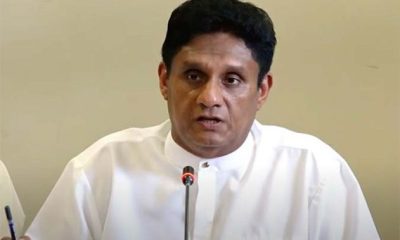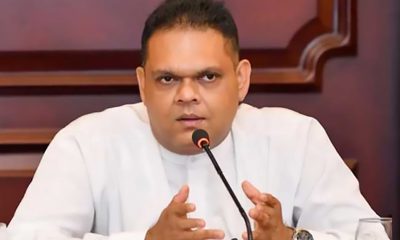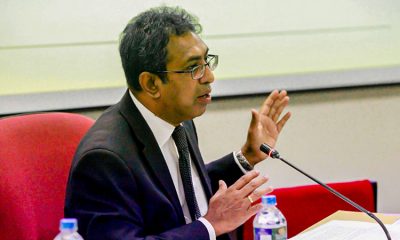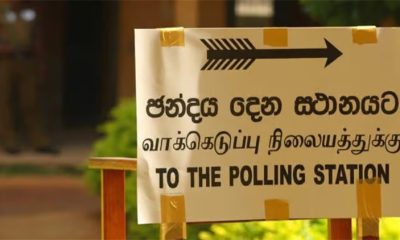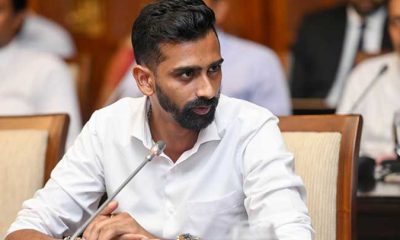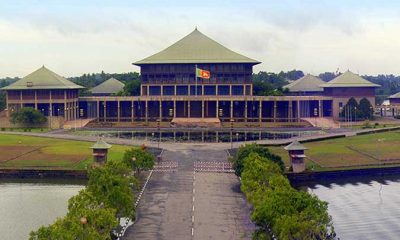Features
The Collapse of the Old Guard and the Wait for the Young Turks
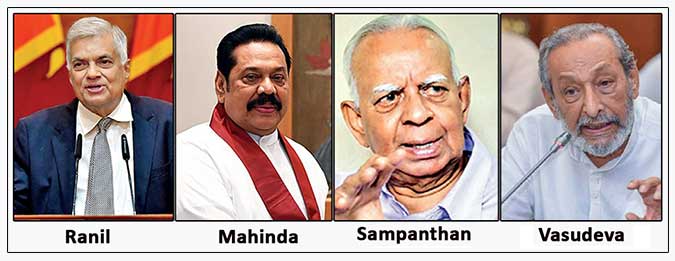
by Rajan Philips
President Wickremesinghe’s political days are numbered in more ways than one. There are virtually none left for Mahinda Rajapaksa. The oldest of them, R. Sampanthan, is under pressure to formally retire. Vasudeva Nanayakkara has not been heard in a while, but he too belongs to the cohort of politicians who entered parliament in 1970 or 1977. They respectively came from Colombo, Hambantota, Galle/Kiriella and Trincomalee, and belonged to the UNP, the SLFP, the TULF and the LSSP – four parties that spanned the entire political spectrum of Sri Lanka in the 20th century.
Vasudeva Nanayakkara was 30 years old, and Mahinda Rajapaksa was 25, when they entered parliament in 1970. Ranil Wickremesinghe was 28 and Sampanthan was 44 when they entered parliament seven years later in 1977. As they are on their way out they are also symptomatic of the state of their political parties, if not the state of politics in the country. Not to mention the economy.
Not many are waiting in the wings to replace them. The public focus is on two men: Anura Kumara Dissanayake (55) and Sajith Premadasa (56). The latter leads the SJB with a larger representation in parliament and is the leader of the opposition. The former has only two JVP/NPP MPs with him in parliament, but is steadily rising in political popularity in the country. Both are untested in national leadership, and they are waiting for their turn at a time when the country is waiting to overcome the most trying challenges it has ever faced in its modern history.
Historical Parallels
Historical parallels may not mean much but are useful to assess the seriousness of the current challenges and the scarceness of national capacity to meet them. Politics in 1970 and 1977 was both energizing and optimistic with two opposing visions that were advocated by impressively talented leaders. The public was engaged and had clear alternative choices. Neither is the case now. That does not mean either Dissanayake or Premadasa cannot mobilize their organizations and rise to the occasion. It only means that the onus is on them to show what they are made of and what teams they will assemble for the next parliament – teams with depths of talent and dedication, and nothing of the corrupt and the incompetent. The time for demonstration is now, well in advance of whatever election that comes first sometimes next year.
Another parallel can be drawn from the time of independence when political competition was between DS Senanayake, who was emerging as the elder statesman – from being nobody to somebody, as Kumari Jayawardena has chronicled, and the young Turks of the time – SWRD Bandaranaike, GG Ponnambalam and Philip Gunawardena. For nearly 15 years preceding independence, the three men, with remarkable abilities and even more remarkable ambitions, had been stalking DS Senanayake to wrest control of the country’s political leadership. Each was on his own path that was exclusive to himself either egotistically or ideologically. Yet their politics was of a high order.
SWRD was the centrist of the three, jostling for position both within and outside the orbit of DS Senanayake, discreetly building his independent base through the Sinhala Maha Sabha, and being strategically ambivalent in confronting colonial rule. GG Ponnambalam was unabashedly pro-colonial and was trying to project himself as the representational champion of the minorities with his technically sound but politically untenable 50-50 cry. Philip Gunawardena was the implacable anti-imperialist, cantankerous by nature, but yet the inspirational leader of Sri Lanka’s first political party, the LSSP.
What was common to all three men was that each was convinced that he was far more able and equipped for political leadership than DS Senanayake during what were clearly the twilight years of colonial rule. But the wily old Senanayake bested them all. Bandaranaike and Ponnambalam became Ministers in the first Senanayake cabinet, although Mr. Bandaranaike would soon leave to set up his own political party, the SLFP that became his vehicle to power in 1956. Ponnambalam dazzled for a while, but his fortunes dwindled soon after DS Senanayake’s sudden death in 1952. Philip became isolated even within the left movement and except for a brief cameo as a consequential cabinet minister in 1956, his early promises gradually evaporated.
Contrast DS Senanayake and his detractors with Ranil Wickremesinghe and his rivals. Nothing more needs to be said. Or contrast the promises of that time with the predicaments of today. The predicaments that our current contenders for power, Anura Kumara Dissanayake and Sajith Premadasa, have to deal with had their origins in the political questions that preoccupied the time of independence and the years after it. The 20th century legacies of the constitution, the ethnic question and the economy are haunting us still.
20th Century Legacies
First, there was and there is, the constitution. Independence arrived on the back of a new constitution, the Soulbury Constitution; rather, the Jennings Constitution. Dr. Nihal Jayawickrama recently described it as the finest of the three constitutions we have had over 75 years. The late Newton Gunasinghe, Marxist and Socialist, used to say the same thing. Here we are today debating the possibility of reverting back to parliamentary democracy that characterized the Jennings Constitution, and jettisoning the current presidential system that is enshrined by the Jayewardene Constitution.
Second, and inextricably tied to the constitution was, and is, the ethnic question. The Jennings Constitution was predicated on what AJ Wilson called the “communal compact,” a supposed understanding between the leaders of the different ethnic communities about the constitutional safeguards for minority rights.
The safeguards were primarily Section 29 of the Constitution, public sector hiring, and the formula for political representation based on population and electoral areas. As it turned out, the safeguards were breached almost from the morrow of independence. The judiciary was independent, but often sided with the government on constitutional questions.
The first breach was the disenfranchisement of the estate Tamils soon after independence. The mass of stateless people in the estates along with the mass of settlers from the south colonizing the eastern province, totally invalidated the constitutional formula for minority representation in parliament. Then came the language question and the opening of the floodgates first in public sector hiring and later in university admissions. The 1972 and 1978 constitutions simply removed the pretense of safeguards that the 1947 constitution had included in its provisions.
The 13th Amendment to the current Constitution belatedly addressed the earlier breaches, but there is more debate about 13A-plus than there is real commitment to implementing what is already part of the constitution. In addition to the 13th Amendment, the citizenship question of the estate Tamils has also been ‘resolved.’ There was never going to be an equitable resolution after nearly half the estate population was repatriated to India, but there is now some finality to it.
It so happens that this month of November marks the bicentenary of the first arrival of the ancestors of the estate Tamils as indentured labourers from Tamil Nadu. The have been commemorations and celebrations throughout this year under the rubric, “Naam 200” (We are 200), but the most recent one at the Sugathadasa Stadium in Colombo would seem to have bordered on the farcical.
The event was organized under the auspices of Jeevan Thondaman in his capacity as Minister of Water Supply and Estate Infrastructure Development (another instance of Ranil Wickremesinghe’s bizarre mixing of ministerial portfolios). More famously, the young Thondaman is the grandson of the CWC patriarch, the late S. Thondaman. The event had more to do with who was invited and who was excluded, and less to with the people on the estates. And the invitations were selectively extended to the BJP in India and the BJP put on a better show in Colombo than it could ever do in Chennai.
The resolution of the citizenship of the estate Tamils, the emergence of territorially defined Muslim political parties, and the exodus of Sri Lankan Tamils, have transformed the ethnic question from what it was for most of the 20th century. The Sri Lankan Tamils are no longer the ‘majority’ in the minority question. The tri-lingual fluency of the Muslims and the estate Tamils is also transforming the linguistic landscape of the island. The retirement of the TNA leader, R. Sampanthan will create its own unique vacuum. President Wickremesinghe tried to fast track reconciliation, but his efforts were undone because his motives were self-serving.
It was known then that it was Sampanthan who persuaded Ranil Wickremesinghe to support Maithripala Sirisena as the common opposition candidate for the 2015 presidential election. Now, there are no indications as to which way the minority political parties will sway, and what offers will be made by Anura Kumara Dissanayake or Sajith Premadasa to make them (minorities) sway their way.
The elephant in the room of course is the economy. It was the most promising of all the prospects at the time of independence. Today it is biggest burden on the country and its future. Ranil Wickremesinghe often brags about the state of the economy under DS Senanayake, even though much of the economy at that time was leftover from colonial rule. Anura Kumara Dissanayake, on the other hand, once blamed the entire political history after independence for the economic mess that Gotabaya Rajapaksa singlehandedly created.
Mr. Dissanayake’s rhetoric was obviously over the top although it was understandable in the context of his insisting two years ago that the JVP/NPP was ready to take over the leadership of the country. Now that Mr. Dissanayake is becoming a real contender for power, the people will expect to hear from him as much substance as political rhetoric. There will be similar expectations and pressure on Sajith Premadasa who is currently trailing the JVP leader by some distance in opinion polling. It is always a long way to power. The journey is still starting.
Features
The heart-friendly health minister

by Dr Gotabhya Ranasinghe
Senior Consultant Cardiologist
National Hospital Sri Lanka
When we sought a meeting with Hon Dr. Ramesh Pathirana, Minister of Health, he graciously cleared his busy schedule to accommodate us. Renowned for his attentive listening and deep understanding, Minister Pathirana is dedicated to advancing the health sector. His openness and transparency exemplify the qualities of an exemplary politician and minister.
Dr. Palitha Mahipala, the current Health Secretary, demonstrates both commendable enthusiasm and unwavering support. This combination of attributes makes him a highly compatible colleague for the esteemed Minister of Health.
Our discussion centered on a project that has been in the works for the past 30 years, one that no other minister had managed to advance.
Minister Pathirana, however, recognized the project’s significance and its potential to revolutionize care for heart patients.
The project involves the construction of a state-of-the-art facility at the premises of the National Hospital Colombo. The project’s location within the premises of the National Hospital underscores its importance and relevance to the healthcare infrastructure of the nation.
This facility will include a cardiology building and a tertiary care center, equipped with the latest technology to handle and treat all types of heart-related conditions and surgeries.
Securing funding was a major milestone for this initiative. Minister Pathirana successfully obtained approval for a $40 billion loan from the Asian Development Bank. With the funding in place, the foundation stone is scheduled to be laid in September this year, and construction will begin in January 2025.
This project guarantees a consistent and uninterrupted supply of stents and related medications for heart patients. As a result, patients will have timely access to essential medical supplies during their treatment and recovery. By securing these critical resources, the project aims to enhance patient outcomes, minimize treatment delays, and maintain the highest standards of cardiac care.
Upon its fruition, this monumental building will serve as a beacon of hope and healing, symbolizing the unwavering dedication to improving patient outcomes and fostering a healthier society.We anticipate a future marked by significant progress and positive outcomes in Sri Lanka’s cardiovascular treatment landscape within the foreseeable timeframe.
Features
A LOVING TRIBUTE TO JESUIT FR. ALOYSIUS PIERIS ON HIS 90th BIRTHDAY

by Fr. Emmanuel Fernando, OMI
Jesuit Fr. Aloysius Pieris (affectionately called Fr. Aloy) celebrated his 90th birthday on April 9, 2024 and I, as the editor of our Oblate Journal, THE MISSIONARY OBLATE had gone to press by that time. Immediately I decided to publish an article, appreciating the untiring selfless services he continues to offer for inter-Faith dialogue, the renewal of the Catholic Church, his concern for the poor and the suffering Sri Lankan masses and to me, the present writer.
It was in 1988, when I was appointed Director of the Oblate Scholastics at Ampitiya by the then Oblate Provincial Fr. Anselm Silva, that I came to know Fr. Aloy more closely. Knowing well his expertise in matters spiritual, theological, Indological and pastoral, and with the collaborative spirit of my companion-formators, our Oblate Scholastics were sent to Tulana, the Research and Encounter Centre, Kelaniya, of which he is the Founder-Director, for ‘exposure-programmes’ on matters spiritual, biblical, theological and pastoral. Some of these dimensions according to my view and that of my companion-formators, were not available at the National Seminary, Ampitiya.
Ever since that time, our Oblate formators/ accompaniers at the Oblate Scholasticate, Ampitiya , have continued to send our Oblate Scholastics to Tulana Centre for deepening their insights and convictions regarding matters needed to serve the people in today’s context. Fr. Aloy also had tried very enthusiastically with the Oblate team headed by Frs. Oswald Firth and Clement Waidyasekara to begin a Theologate, directed by the Religious Congregations in Sri Lanka, for the contextual formation/ accompaniment of their members. It should very well be a desired goal of the Leaders / Provincials of the Religious Congregations.
Besides being a formator/accompanier at the Oblate Scholasticate, I was entrusted also with the task of editing and publishing our Oblate journal, ‘The Missionary Oblate’. To maintain the quality of the journal I continue to depend on Fr. Aloy for his thought-provoking and stimulating articles on Biblical Spirituality, Biblical Theology and Ecclesiology. I am very grateful to him for his generous assistance. Of late, his writings on renewal of the Church, initiated by Pope St. John XX111 and continued by Pope Francis through the Synodal path, published in our Oblate journal, enable our readers to focus their attention also on the needed renewal in the Catholic Church in Sri Lanka. Fr. Aloy appreciated very much the Synodal path adopted by the Jesuit Pope Francis for the renewal of the Church, rooted very much on prayerful discernment. In my Religious and presbyteral life, Fr.Aloy continues to be my spiritual animator / guide and ongoing formator / acccompanier.
Fr. Aloysius Pieris, BA Hons (Lond), LPh (SHC, India), STL (PFT, Naples), PhD (SLU/VC), ThD (Tilburg), D.Ltt (KU), has been one of the eminent Asian theologians well recognized internationally and one who has lectured and held visiting chairs in many universities both in the West and in the East. Many members of Religious Congregations from Asian countries have benefited from his lectures and guidance in the East Asian Pastoral Institute (EAPI) in Manila, Philippines. He had been a Theologian consulted by the Federation of Asian Bishops’ Conferences for many years. During his professorship at the Gregorian University in Rome, he was called to be a member of a special group of advisers on other religions consulted by Pope Paul VI.
Fr. Aloy is the author of more than 30 books and well over 500 Research Papers. Some of his books and articles have been translated and published in several countries. Among those books, one can find the following: 1) The Genesis of an Asian Theology of Liberation (An Autobiographical Excursus on the Art of Theologising in Asia, 2) An Asian Theology of Liberation, 3) Providential Timeliness of Vatican 11 (a long-overdue halt to a scandalous millennium, 4) Give Vatican 11 a chance, 5) Leadership in the Church, 6) Relishing our faith in working for justice (Themes for study and discussion), 7) A Message meant mainly, not exclusively for Jesuits (Background information necessary for helping Francis renew the Church), 8) Lent in Lanka (Reflections and Resolutions, 9) Love meets wisdom (A Christian Experience of Buddhism, 10) Fire and Water 11) God’s Reign for God’s poor, 12) Our Unhiddden Agenda (How we Jesuits work, pray and form our men). He is also the Editor of two journals, Vagdevi, Journal of Religious Reflection and Dialogue, New Series.
Fr. Aloy has a BA in Pali and Sanskrit from the University of London and a Ph.D in Buddhist Philosophy from the University of Sri Lankan, Vidyodaya Campus. On Nov. 23, 2019, he was awarded the prestigious honorary Doctorate of Literature (D.Litt) by the Chancellor of the University of Kelaniya, the Most Venerable Welamitiyawe Dharmakirthi Sri Kusala Dhamma Thera.
Fr. Aloy continues to be a promoter of Gospel values and virtues. Justice as a constitutive dimension of love and social concern for the downtrodden masses are very much noted in his life and work. He had very much appreciated the commitment of the late Fr. Joseph (Joe) Fernando, the National Director of the Social and Economic Centre (SEDEC) for the poor.
In Sri Lanka, a few religious Congregations – the Good Shepherd Sisters, the Christian Brothers, the Marist Brothers and the Oblates – have invited him to animate their members especially during their Provincial Congresses, Chapters and International Conferences. The mainline Christian Churches also have sought his advice and followed his seminars. I, for one, regret very much, that the Sri Lankan authorities of the Catholic Church –today’s Hierarchy—- have not sought Fr.
Aloy’s expertise for the renewal of the Catholic Church in Sri Lanka and thus have not benefited from the immense store of wisdom and insight that he can offer to our local Church while the Sri Lankan bishops who governed the Catholic church in the immediate aftermath of the Second Vatican Council (Edmund Fernando OMI, Anthony de Saram, Leo Nanayakkara OSB, Frank Marcus Fernando, Paul Perera,) visited him and consulted him on many matters. Among the Tamil Bishops, Bishop Rayappu Joseph was keeping close contact with him and Bishop J. Deogupillai hosted him and his team visiting him after the horrible Black July massacre of Tamils.
Features
A fairy tale, success or debacle

Sri Lanka-Singapore Free Trade Agreement
By Gomi Senadhira
senadhiragomi@gmail.com
“You might tell fairy tales, but the progress of a country cannot be achieved through such narratives. A country cannot be developed by making false promises. The country moved backward because of the electoral promises made by political parties throughout time. We have witnessed that the ultimate result of this is the country becoming bankrupt. Unfortunately, many segments of the population have not come to realize this yet.” – President Ranil Wickremesinghe, 2024 Budget speech
Any Sri Lankan would agree with the above words of President Wickremesinghe on the false promises our politicians and officials make and the fairy tales they narrate which bankrupted this country. So, to understand this, let’s look at one such fairy tale with lots of false promises; Ranil Wickremesinghe’s greatest achievement in the area of international trade and investment promotion during the Yahapalana period, Sri Lanka-Singapore Free Trade Agreement (SLSFTA).
It is appropriate and timely to do it now as Finance Minister Wickremesinghe has just presented to parliament a bill on the National Policy on Economic Transformation which includes the establishment of an Office for International Trade and the Sri Lanka Institute of Economics and International Trade.
Was SLSFTA a “Cleverly negotiated Free Trade Agreement” as stated by the (former) Minister of Development Strategies and International Trade Malik Samarawickrama during the Parliamentary Debate on the SLSFTA in July 2018, or a colossal blunder covered up with lies, false promises, and fairy tales? After SLSFTA was signed there were a number of fairy tales published on this agreement by the Ministry of Development Strategies and International, Institute of Policy Studies, and others.
However, for this article, I would like to limit my comments to the speech by Minister Samarawickrama during the Parliamentary Debate, and the two most important areas in the agreement which were covered up with lies, fairy tales, and false promises, namely: revenue loss for Sri Lanka and Investment from Singapore. On the other important area, “Waste products dumping” I do not want to comment here as I have written extensively on the issue.
1. The revenue loss
During the Parliamentary Debate in July 2018, Minister Samarawickrama stated “…. let me reiterate that this FTA with Singapore has been very cleverly negotiated by us…. The liberalisation programme under this FTA has been carefully designed to have the least impact on domestic industry and revenue collection. We have included all revenue sensitive items in the negative list of items which will not be subject to removal of tariff. Therefore, 97.8% revenue from Customs duty is protected. Our tariff liberalisation will take place over a period of 12-15 years! In fact, the revenue earned through tariffs on goods imported from Singapore last year was Rs. 35 billion.
The revenue loss for over the next 15 years due to the FTA is only Rs. 733 million– which when annualised, on average, is just Rs. 51 million. That is just 0.14% per year! So anyone who claims the Singapore FTA causes revenue loss to the Government cannot do basic arithmetic! Mr. Speaker, in conclusion, I call on my fellow members of this House – don’t mislead the public with baseless criticism that is not grounded in facts. Don’t look at petty politics and use these issues for your own political survival.”
I was surprised to read the minister’s speech because an article published in January 2018 in “The Straits Times“, based on information released by the Singaporean Negotiators stated, “…. With the FTA, tariff savings for Singapore exports are estimated to hit $10 million annually“.
As the annual tariff savings (that is the revenue loss for Sri Lanka) calculated by the Singaporean Negotiators, Singaporean $ 10 million (Sri Lankan rupees 1,200 million in 2018) was way above the rupees’ 733 million revenue loss for 15 years estimated by the Sri Lankan negotiators, it was clear to any observer that one of the parties to the agreement had not done the basic arithmetic!
Six years later, according to a report published by “The Morning” newspaper, speaking at the Committee on Public Finance (COPF) on 7th May 2024, Mr Samarawickrama’s chief trade negotiator K.J. Weerasinghehad had admitted “…. that forecasted revenue loss for the Government of Sri Lanka through the Singapore FTA is Rs. 450 million in 2023 and Rs. 1.3 billion in 2024.”
If these numbers are correct, as tariff liberalisation under the SLSFTA has just started, we will pass Rs 2 billion very soon. Then, the question is how Sri Lanka’s trade negotiators made such a colossal blunder. Didn’t they do their basic arithmetic? If they didn’t know how to do basic arithmetic they should have at least done their basic readings. For example, the headline of the article published in The Straits Times in January 2018 was “Singapore, Sri Lanka sign FTA, annual savings of $10m expected”.
Anyway, as Sri Lanka’s chief negotiator reiterated at the COPF meeting that “…. since 99% of the tariffs in Singapore have zero rates of duty, Sri Lanka has agreed on 80% tariff liberalisation over a period of 15 years while expecting Singapore investments to address the imbalance in trade,” let’s turn towards investment.
Investment from Singapore
In July 2018, speaking during the Parliamentary Debate on the FTA this is what Minister Malik Samarawickrama stated on investment from Singapore, “Already, thanks to this FTA, in just the past two-and-a-half months since the agreement came into effect we have received a proposal from Singapore for investment amounting to $ 14.8 billion in an oil refinery for export of petroleum products. In addition, we have proposals for a steel manufacturing plant for exports ($ 1 billion investment), flour milling plant ($ 50 million), sugar refinery ($ 200 million). This adds up to more than $ 16.05 billion in the pipeline on these projects alone.
And all of these projects will create thousands of more jobs for our people. In principle approval has already been granted by the BOI and the investors are awaiting the release of land the environmental approvals to commence the project.
I request the Opposition and those with vested interests to change their narrow-minded thinking and join us to develop our country. We must always look at what is best for the whole community, not just the few who may oppose. We owe it to our people to courageously take decisions that will change their lives for the better.”
According to the media report I quoted earlier, speaking at the Committee on Public Finance (COPF) Chief Negotiator Weerasinghe has admitted that Sri Lanka was not happy with overall Singapore investments that have come in the past few years in return for the trade liberalisation under the Singapore-Sri Lanka Free Trade Agreement. He has added that between 2021 and 2023 the total investment from Singapore had been around $162 million!
What happened to those projects worth $16 billion negotiated, thanks to the SLSFTA, in just the two-and-a-half months after the agreement came into effect and approved by the BOI? I do not know about the steel manufacturing plant for exports ($ 1 billion investment), flour milling plant ($ 50 million) and sugar refinery ($ 200 million).
However, story of the multibillion-dollar investment in the Petroleum Refinery unfolded in a manner that would qualify it as the best fairy tale with false promises presented by our politicians and the officials, prior to 2019 elections.
Though many Sri Lankans got to know, through the media which repeatedly highlighted a plethora of issues surrounding the project and the questionable credentials of the Singaporean investor, the construction work on the Mirrijiwela Oil Refinery along with the cement factory began on the24th of March 2019 with a bang and Minister Ranil Wickremesinghe and his ministers along with the foreign and local dignitaries laid the foundation stones.
That was few months before the 2019 Presidential elections. Inaugurating the construction work Prime Minister Ranil Wickremesinghe said the projects will create thousands of job opportunities in the area and surrounding districts.
The oil refinery, which was to be built over 200 acres of land, with the capacity to refine 200,000 barrels of crude oil per day, was to generate US$7 billion of exports and create 1,500 direct and 3,000 indirect jobs. The construction of the refinery was to be completed in 44 months. Four years later, in August 2023 the Cabinet of Ministers approved the proposal presented by President Ranil Wickremesinghe to cancel the agreement with the investors of the refinery as the project has not been implemented! Can they explain to the country how much money was wasted to produce that fairy tale?
It is obvious that the President, ministers, and officials had made huge blunders and had deliberately misled the public and the parliament on the revenue loss and potential investment from SLSFTA with fairy tales and false promises.
As the president himself said, a country cannot be developed by making false promises or with fairy tales and these false promises and fairy tales had bankrupted the country. “Unfortunately, many segments of the population have not come to realize this yet”.
(The writer, a specialist and an activist on trade and development issues . )


